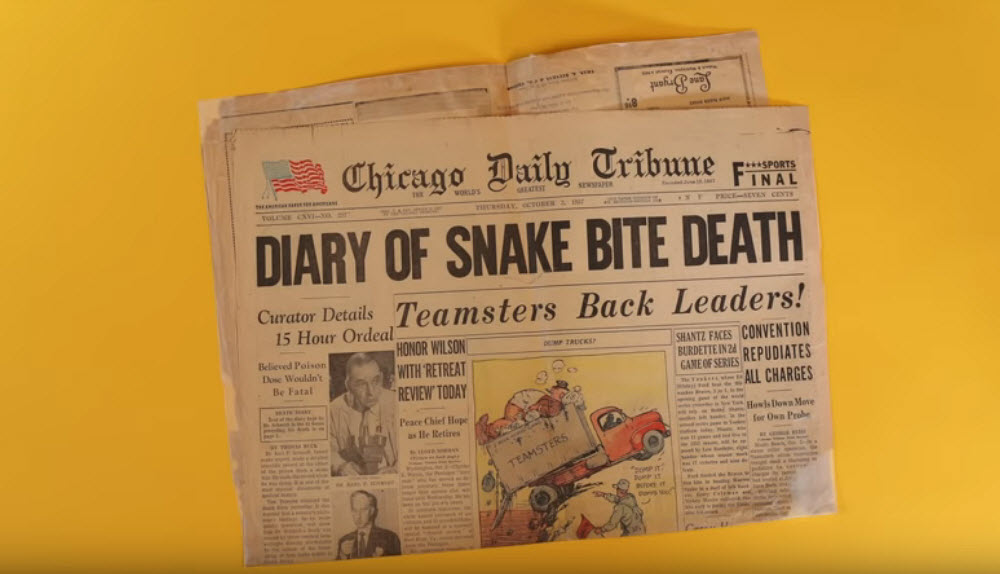Karl Patterson Schmidt was an eminent American herpetologist—one who studies amphibians and reptiles. He worked for the American Museum of Natural History in New York and then for the Field Museum in Chicago, during which he made several expedition to Central and South America to collect specimens for the museum. He was also the president of the American Society of Ichthyologists and Herpetologists. During his long scientific career, Schmidt handled countless deadly snakes. But in 1957, he made the fatal mistake of underestimating the toxicity of a juvenile boomslang snake, sent to him by the director of the Lincoln Park Zoo for identification. While examining the serpent with his colleagues, the agitated snake opened its mouth and buried its fangs into the flesh of Schmidt’s left thumb.

“I took it from Dr. Robert Inger without thinking of any precaution, and it promptly bit me on the fleshy lateral aspect of the first joint of the left thumb,” Karl Schmidt wrote in his journal. “The mouth was widely opened and the bite was made with the rear fangs only, only the right fang entering to its full length of about 3 mm.”
Less that 24 hours later, he was dead.
Karl Schmidt, like many herpetologists at the time, didn't believe that boomslang venom had the fatal dose necessary to kill humans, although peer-reviewed studies showed otherwise. Instead of treating his bite wound, Schmidt took the train home from work, and began to record the effect of the venom in his journal. Schmidt believed that accepting treatment would upset the symptoms he was documenting.
He wrote in his journal:
4:30 - 5:30 PM strong nausea but without vomiting. During a trip to Homewood went on a suburban train.
5:30 - 6:30 PM strong chill and shaking followed by fever of 101.7. Bleeding of mucus membranes in the mouth began about 5:30, apparently mostly from gums.
8:30 PM ate two pieces of milk toast.
9:00 to 12:20 A.M. slept well. Urination at 12:20 AM mostly blood but a small amount. Took a glass of water at 4:30 AM, followed by violent nausea and vomiting, the contents of the stomach being the undigested supper. Felt much better and slept until 6:30 AM.
After waking, Schmidt continued recording his observations:
September 26. 6:30 AM Temperature 98.2. Ate cereal and poached eggs on toast and apple sauce and coffee for breakfast. No urine with an ounce or so of blood about every three hours. Mouth and nose continuing to bleed, not excessively.

Schmidt’s conditions began to turn worse after lunch. He called his wife but by the time help arrived, Schmidt was struggling to breath and was unresponsive. Resuscitation was attempted and failed. Just before 3 PM on September 26, 1957, Schmidt arrived at the hospital and was pronounced dead. His autopsy revealed extensive internal bleeding.
Today, the boomslang (Dispholidus typus) is considered one of Africa’s most deadly snakes. Typical symptoms after a bite includes disseminated intravascular coagulation—a condition where small blood clots develop throughout the bloodstream, blocking small blood vessels—followed by spontaneous hemorrhage into tissues. When Schmidt was brought into the hospital, he was bleeding from his eyes, lungs, kidneys, heart, and brain. The victim essentially bleeds to death.
Since the unfortunate incident, many have debated whether Schmidt could have been saved if had sought medical attention immediately. It’s hard to know for sure because at that time, no specific antivenom against boomslang venom was available.

The boomslang snake. Image credit: William Warby/Wikimedia Commons
Ironically, the boomslang is actually a timid snake that will flee from anything too large to eat, and will bite only when people attempt to handle, catch or kill the animal. Schmidt’s death was a result of carelessness, emboldened by the false prevailing belief in the scientific community of that time that boomslangs were harmless snakes.
Schmidt was one of the most important herpetologists in the 20th century. He named more than 200 species and was a leading expert on coral snakes.His donation of over 15,000 titles of herpetological literature formed the foundation for The Karl P. Schmidt Memorial Herpetological Library located at the Field Museum.
References:
# DaviniaPla. et al, What killed Karl Patterson Schmidt? Combined venom gland transcriptomic, venomic and antivenomic analysis of the South African green tree snake (the boomslang), Dispholidus typus
# Bite from the past: new study on boomslang venom provides insights into the death of renowned herpetologist Karl Schmidt, https://www.discovermagazine.com/planet-earth/bite-from-the-past-new-study-on-boomslang-venom-provides-insights-into-the-death-of-renowned-herpetologist-karl-schmidt
# He documented his own death by snakebite instead of going to the hospital, https://www.pri.org/stories/2015-11-10/he-documented-his-own-death-snakebite-instead-going-hospital



Comments
Post a Comment